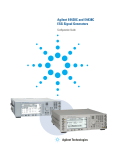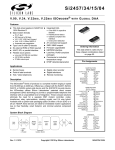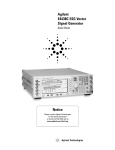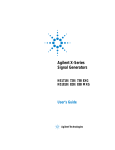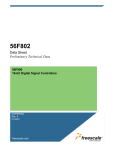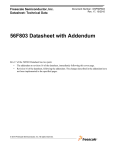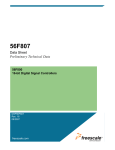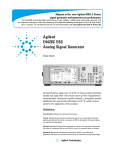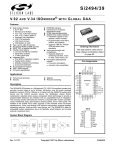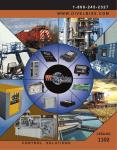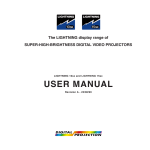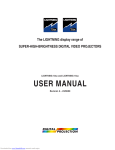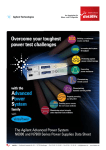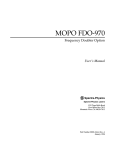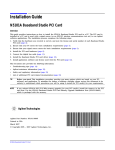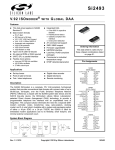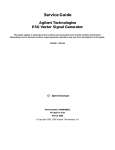Download Keysight-Agilent E4438C Datasheet
Transcript
Test Equipment Solutions Datasheet Test Equipment Solutions Ltd specialise in the second user sale, rental and distribution of quality test & measurement (T&M) equipment. We stock all major equipment types such as spectrum analyzers, signal generators, oscilloscopes, power meters, logic analysers etc from all the major suppliers such as Agilent, Tektronix, Anritsu and Rohde & Schwarz. We are focused at the professional end of the marketplace, primarily working with customers for whom high performance, quality and service are key, whilst realising the cost savings that second user equipment offers. As such, we fully test & refurbish equipment in our in-house, traceable Lab. Items are supplied with manuals, accessories and typically a full no-quibble 2 year warranty. Our staff have extensive backgrounds in T&M, totalling over 150 years of combined experience, which enables us to deliver industry-leading service and support. We endeavour to be customer focused in every way right down to the detail, such as offering free delivery on sales, covering the cost of warranty returns BOTH ways (plus supplying a loan unit, if available) and supplying a free business tool with every order. As well as the headline benefit of cost saving, second user offers shorter lead times, higher reliability and multivendor solutions. Rental, of course, is ideal for shorter term needs and offers fast delivery, flexibility, try-before-you-buy, zero capital expenditure, lower risk and off balance sheet accounting. Both second user and rental improve the key business measure of Return On Capital Employed. We are based near Heathrow Airport in the UK from where we supply test equipment worldwide. Our facility incorporates Sales, Support, Admin, Logistics and our own in-house Lab. All products supplied by Test Equipment Solutions include: - No-quibble parts & labour warranty (we provide transport for UK mainland addresses). - Free loan equipment during warranty repair, if available. - Full electrical, mechanical and safety refurbishment in our in-house Lab. - Certificate of Conformance (calibration available on request). - Manuals and accessories required for normal operation. - Free insured delivery to your UK mainland address (sales). - Support from our team of seasoned Test & Measurement engineers. - ISO9001 quality assurance. Test equipment Solutions Ltd Unit 8 Elder Way Waterside Drive Langley Berkshire SL3 6EP T: +44 (0)1753 596000 F: +44 (0)1753 596001 Email: [email protected] Web: www.TestEquipmentHQ.com Signal Generators 298 E4438C Vector Signal Generators (cont.) • • • • 6 GHz frequency range 160 MHz RF modulation bandwidth 320 Mbytes baseband memory 6 Gbyte non-volatile waveform storage Powerful Standard Features • Excellent spectral purity • Electronic attenuator • Simple softkey menu structure allows access to sophisticated features • Built-in help • Differential and single-ended I/Q outputs • Suite of I/Q adjustments: gain, DC offsets, quadrature skew • Save and recall instrument settings • IntuiLink software allows easy data exchange from Microsoft® applications • 10BaseT LAN and GPIB interfaces Superior Dual Mode Baseband Generator E4438C RF Vector Signal Generator 4 The Agilent E4438C ESG vector signal generator meets the needs of engineers who are designing and developing the next generation of wireless communication systems and is well suited for production test environments. An assortment of standards-based receiver and component test software for 3G and emerging communications formats are available to simplify the signal configuration process. The E4438C ESG vector signal generator’s performance, extended frequency range, increased memory for waveform playback and storage, and application-specific personalities make it the clear choice for development and manufacturing from the component to the system level. 6 GHz Frequency Range E4438C ESG provides different frequency options to suit your need: 1, 2, 3, 4 or 6 GHz • Dual mode capability supports both waveform playback and real-time signal generation • 80 MHz RF modulation bandwidth • 64 Msamples (320 Mbytes) of waveform playback memory • Generate waveforms at up to 100 Msamples/s • Hardware resampling technology eliminates need for multiple reconstruction filters • 16-bit DAC for improved dynamic range • Flexible baseband reference clock 250 kHz to 100 MHz • Industry standard filters or user-definable FIR filters • Set Eb/No or C/N ratio for W-CDMA, cdma2000, WiMAX, Digital Video, and more • Generate AWGN with up to 80 MHz bandwidth • Generate phase coherent carriers • Polar modulation Baseband Studio Baseband Studio is a suite of baseband signal applications and accessories that work with the E4438C ESG vector signal generator to emulate real-world signal conditions. • Fading • Digital inputs and outputs • Waveform capture and playback • CPRI RE test For more information, go to page 341 160 MHz RF Modulation Bandwidth Signal Creation Software • Ideal for multi-carrier signals • Up to 160 MHz RF modulation bandwidth using external I/Q inputs • 80 MHz RF modulation bandwidth using internal baseband generator The software is used for the development and generation of waveforms with the internal baseband generator. • TD-SCDMA • AWGN • W-CDMA • Noise power ratio • EDGE/GSM • Enhanced multitone • 1xEV-DO/1xEV-DV • Custom • cdma2000/cdmaOne • Pulse • NADC/PDC • M/AM/FM • PHS • S-DMB • DECT • HSDPA • TETRA • Pulse building • GPS • Jitter injection • 802.11a/b/g/j/p/n WLAN • 802.16 (WiMAX) • Bluetooth™ • Digital Video • T-DMB • DVB-T/H/C/S, ISDB-T, ATSC, DTMB • Toolkit 320 Mbytes Baseband Memory • 64 Msamples (320 Mbytes) for waveform playback • 64x the memory of the previous generation • Build longer, more complex waveforms 6 Gbytes Non-Volatile Memory • 1.2 Gsamples (6 Gbytes) for storing waveforms and instrument states • Eliminate waveform build times in manufacturing and development English URL www.agilent.com/find/products For more information, go to page 310 Signal Generators Vector Signal Generators (cont.) Specifications For Frequency and Power Characteristics Level Accuracy [dB] Frequency Frequency Range Option: • 501: 250 kHz to 1 GHz • 502: 250 kHz to 2 GHz • 503: 250 kHz to 3 GHz • 504: 250 kHz to 4 GHz • 506: 250 kHz to 6 GHz (requires Option UNJ) Frequency Minimum 100 kHz1 Frequency Resolution 0.01 Hz Frequency Switching Speed4 Option 501-504 (<35 ms) (<52 ms) (<9 ms) (<9 ms) [For hops <5 MHz within a band] Digital modulation on (<9 ms) (<9 ms) (<9 ms) (<9 ms) off (<9 ms) (<9 ms) (<9 ms) (<9 ms) 250 kHz to 2 GHz 2 to 3 GHz 3 to 4 Ghz (<41 ms) (<57 ms) (<16 ms) (<17 ms) (<33 ms) (<53 ms) (<12 ms) (<14 ms) <±1 ppm/yr <±0.1 ppm/yr or <±0.0005 ppm/day after 45 days (<±1 ppm) (<±0.05 ppm) (<±0.1 ppm) (<±0.002 ppm) (+5% to –10%) (+5% to –10%) ±0.5 ±0.6 ±0.6 ±0.5 ±0.6 ±0.7 ±0.7 ±0.8 ±0.8 (±1.5) (±2.5) (±2.5) +10 to –50 dBm –50 to –120 dBm –120 to –127 dBm <–127 dBm 250 kHz to 2 GHz 2 to 3 GHz 3 to 4 GHz ±0.5 ±0.6 ±0.8 ±0.7 ±0.8 ±0.9 ±0.8 ±1.0 ±1.3 (±1.5) (±2.5) (±2.5) +7 to –50 dBm –50 to –110 dBm –110 to –127 dBm <–127 dBm ±0.6 ±0.6 ±0.8 ±0.8 ±0.8 ±0.8 ±0.9 ±0.9 ±0.8 ±1.0 ±1.5 (±1.5) (±1.5) (±2.5) (±2.5) With Option 5064, 6 250 kHz to 2 GHz 2 to 3 GHz 3 to 4 GHz 4 to 6 GHz Option 501-504 1, 2, 5, 10 MHz ± 0.2 ppm –3.5 dBm to 20 dBm 50 Normal operation [ALC on] (<15 ms) When using power search manual (<83 ms) When using power search auto (<103 ms) Output Power Power Option UNB Option 506 (<21 ms) (<95 ms) (<119 ms) (<21 ms) (<95 ms) (<119 ms) Spectral Purity SSB Phase Noise (at 20 kHz offset)4 Option 501-504 With Option UNB Option 506 +11 to –136 dBm +13 to –136 dBm +10 to –136 dBm +7 to –136 dBm — +15 to –136 dBm +17 to –136 dBm +16 to –136 dBm +13 to –136 dBm — +12 to –136 dBm +14 to –136 dBm +13 to –136 dBm +10 to –136 dBm +10 to –136 dBm Level Resolution 0.02 dB Level Range with Attenuator Hold Active 250 kHz to 1 GHz >1 to 3 GHz >3 to 4 GHz >4 to 6 GHz <–127 dBm Level Accuracy with Digital Modulation Turned On (relative to CW) Conditions: (with PRBS modulated data; if using I/Q inputs, √ I2 + Q2 = 0.5 Vrms, nominal)4 Level Accuracy with ALC on /4 DQPSK or QPSK formats Conditions: With raised cosine or root-raised cosine filter and ≥0.35; with 10 kHz ≤symbol rate ≤1 MHz; at RF freq ≥25 MHz; power ≤max specified –3 dB Option 501-504 With Option 506 ±0.15 dB ±0.25 dB Constant amplitude formats (FSK, GMSK, etc) Option 501-504 With Option 506 ±0.1 dB ±0.15 dB Level Accuracy with ALC off 4, 7 (±0.15 dB) (relative to ALC on) Conditions: After power search is executed, with burst off. 4 Level Switching Speed RF Reference Output • Frequency: 10 MHz • Amplitude: 4 dBm ±2 dB RF Reference Input Requirements 250 kHz to 250 MHz >250 MHz to 1 GHz >1 to 3 GHz >3 to 4 GHz >4 to 6 GHz –120 to –127 dBm Power Level Internal Reference Oscillator (Option 1E5) Stability4 Frequency Amplitude Input impedance –50 to –120 dBm Power Level Sweep Modes Operating Modes Frequency step, amplitude step and arbitrary list Dwell Time 1 ms to 60 s Number of Points 2 to 65, 535 Temp (0 to 55° C) Line voltage Line voltage range +7 to –50 dBm With Option UNB4, 5 Phase Offset Phase is adjustable remotely (LAN, GPIB, RS-232) or via front panel in nominal 0.1° increments Aging rate E4438C Power Level Option 501-504 Option 501-504 w/UNJ With Option 506 Freq.2 Freq./Amp.3 Freq.2 Freq./Amp.3 Freq.2 Freq./Amp.3 Digital modulation on (<35 ms) (<49 ms) off (<9 ms) (<9 ms) Option 501-504 With Option UNB Option 506 23 dB 20 dB 17 dB — 27 dB 26 dB 23 dB — 24 dB 23 dB 20 dB 20 dB at 500 MHz at 1 GHz at 2 GHz at 3 GHz at 4 GHz at 6 GHz Option 501-504 With Option UNJ (<–124 dBc/Hz) (<–118 dBc/Hz) (<–112 dBc/Hz) (<–106 dBc/Hz) (<–106 dBc/Hz) N/A <–135 dBc/Hz, (<–138 dBc/Hz) <–130 dBc/Hz, (<–134 dBc/Hz) <–124 dBc/Hz, (<–128 dBc/Hz) <–121 dBc/Hz, (<–125 dBc/Hz) <–118 dBc/Hz, (<–122 dBc/Hz) <–113 dBc/Hz, (<–117 dBc/Hz) Residual FM4 (CW mode, 0.3 to 3 kHz BW, CCITT, rms) • Option UNJ <N x 1 Hz (<N x 0.5 Hz)8 • Standard – Phase noise mode 1 <N x 2 Hz – Phase noise mode 2 <N x 4 Hz 1 2 3 4 5 6 7 8 English URL www.agilent.com/find/products 299 Performance below 250 kHz not guaranteed. To within 0.1 ppm of final frequency above 250 MHz or within 100 Hz below 250 MHz. Frequency switching time with the amplitude settled within ±0.1 dB. Parentheses denote typical performance. Quoted specifications for 23°C ± 5°C. Accuracy degrades by less than 0.01 dB/°C over full temperature range. Accuracy degrades by 0.2 dB above +10 dBm, and by 0.8 dB above +13 dBm. Quoted specifications for 23°C ± 5°C. Accuracy degrades by less than 0.02 dB/°C over full temperature range. Accuracy degrades by 0.2 dB above +7 dBm. When applying external I/Q signals with ALC off, output level will vary directly with I/Q input level. Refer to frequency bands on next page for N values. 4 Signal Generators 300 Vector Signal Generators (cont.) E4438C Specifications For Analog Modulation Frequency Bands Band Frequency Range N# 1 2 3 4 5 6 250 kHz to ≤250 MHz >250 MHz to ≤500 MHz >500 MHz to ≤1 GHz >1 to ≤2 GHz >2 to ≤4 GHz >4 to ≤6 GHz 1 0.5 1 2 4 8 Frequency Modulation1, 3 Maximum Deviation Option 501-504 With Option UNJ N x 8 MHz N x 1 MHz Resolution 0.1% of deviation or 1 Hz, whichever is greater Modulation Frequency Rate4 (deviation = 100 kHz) Coupling 1 dB Bandwidth 3 dB Bandwidth FM path 1 (DC) FM path 2 (DC) FM path 1 (AC) FM path 2 (AC) DC to 100 kHz DC to 100 kHz 20 Hz to 100 kHz 20 Hz to 100 kHz (DC to 10 MHz) (DC to 0.9 MHz) (5 Hz to 10 MHz) (5 Hz to 0.9 MHz) Deviation Accuracy2 (1 kHz rate, deviation <N x 100 kHz) <±3.5% of FM deviation + 20 Hz Phase Modulation1, 3 Resolution 0.1% of set deviation Modulation Frequency Response4, 5 4 Standard Mode Maximum Deviation Allowable Rates (3 dB BW) M Path 1 M Path 2 Normal BW High BW8 N x 80 rad N x 8 rad N x 1.6 rad DC to 100 kHz (DC to 1 MHz) (DC to 10 MHz) Mode Maximum Deviation Allowable Rates (3 dB BW) M Path 1 M Path 2 Normal BW High BW N x 10 radians N x 1 radians DC to 100 kHz (DC to 1 MHz) DC to 100 kHz (DC to 0.9 MHz) (DC to 0.9 MHz) With Option UNJ DC to 100 kHz (DC to 0.9 MHz) Deviation Accuracy (1 kHz rate, Normal BW mode) <±5% of deviation + 0.01 radians Distortion5 (1 kHz rate, deviation <80 radians on Options 501-504, <10 N radians on Option UNJ models, Normal BW mode) <1% Amplitude Modulation1, 5 (fc >500 kHz) Range 0 to 100% Resolution 0.1% Rates (3 dB bandwidth) • DC coupled: 0 to 10 kHz • AC coupled: 10 Hz to 10 kHz Accuracy4, 7 1 kHz rate <±(6% of setting + 1%) Distortion4, 7 (1 kHz rate, THD) Option 501-504/Option UNJ Option 506 30% AM <1.5% <1.5% 90% AM (<4%) (<5%) Pulse Repetition Frequency4 ALC on (10 Hz to 250 kHz) ALC off (DC to 1.0 MHz) Level Accuracy4, 9 (relative to CW at ≤4 dBm Option 501-504, ≤7.5 dBm Option UNB, ≤4.5 dBm Option 506) (<±1 dB) Internal Pulse Generator • Square wave rate: 0.1 Hz to 20 kHz • Pulse Period: 8 µs to 30 seconds Width: 4 µs to 30 seconds Resolution: 2 µs Internal Analog Modulation Source (Provides FM, AM, pulse, and phase modulation signals and LF audio out) Waveforms sine, square, ramp, triangle, pulse, noise Rate Range Sine 0.1 Hz to 100 kHz Square, ramp, triangle 0.1 Hz to 20 kHz Resolution 0.1 Hz Frequency Accuracy same as RF reference source Swept Sine Mode (frequency, phase continuous) Operating modes Triggered or continuous sweeps Frequency range 0.1 Hz to 100 kHz Sweep time 1 ms to 65 sec Resolution 1 ms Dual Sinewave Mode Frequency range 0.1 Hz to 100 kHz Amplitude ratio 0 to 100% Amplitude ratio Resolution 0.1% External Modulation Inputs Modulation Types Ext 1 FM, M, AM, pulse, and burst envelope Ext 2 FM, M, AM, and pulse LO/HI Indicator (100 Hz to 10 MHz BW, AC coupled inputs only). Activated when input level error exceeds 3% (nominal) External Burst Envelope Input Voltage RF On: 0 V RF Off: –1.0 V Linear Control Range: 0 to –1 V On/Off Ratio4 Condition: Vin below –1.05 V <4 GHz >75 dB ≥4 GHz (>64 dB) 4 Rise/Fall Time Condition: With rectangular input (<2 µs) Minimum Burst Repetition Frequency4 ALC on (10 Hz) ALC off DC Input Port External 1 Input Impedance 50 Ω, nominal Composite Modulation AM, FM, and M each consist of two modulation paths which are summed internally for composite modulation. The modulation sources may be any two of the following: Internal, External 1, External 2 Wideband AM Rates (1 dB bandwidth)4 ALC on (400 Hz to 40 MHz) ALC off (DC to 40 MHz) Simultaneous Modulation Multiple modulation types may be simultaneously enabled with some exceptions. Two modulation types cannot be generated simultaneously by the same modulation source Pulse Modulation On/Off Ratio4 <4 GHz >80 dB ≤4 GHz (>64 dB) Rise/Fall Times4 (150 ns) Minimum Width4 ALC on (2 µs) ALC off (0.4 µs) 1 English URL www.agilent.com/find/products 2 3 4 5 6 7 8 9 All analog performance above 4 GHz is typical. Refer to frequency bands on this page to compute specifications. For non-Option UNJ units, specifications apply in phase noise mode 2 (default). Parentheses denote typical performance. Refer to frequency bands on this page for N. AM is typical above 3 GHz or if wideband AM or I/Q modulation is simultaneously enabled. Peak envelope power of AM must be 3 dB less than maximum output power below 250 MHz. Bandwidth is automatically selected based on deviation. With ALC off, specifications apply after the execution of power search. With ALC on, specifications apply for pulse repetition rates ≤10 kHz and pulse widths ≥5 µs. Signal Generators Vector Signal Generators (cont.) Specifications For I/Q Characteristics I/Q Modulation Bandwidth I/Q Inputs Input impedance 50 Ω or 600 Ω √ I2 + Q2 = 0.5 Vrms Full scale input1 I/Q Bandwidth Using External I/Q Source (ALC off)2 3.00 850 MHz carrier 1.00 -1.00 [dB] -3.00 -5.00 -7.00 1900 MHz carrier 2200 MHz carrier 1800 MHz carrier -9.00 -11.00 -13.00 -15.00 -150 -100 -50 0 50 100 150 Frequency offset from carrier [MHz] I/Q Bandwidth Using Internal I/Q Source 3.00 1.00 -1.00 -3.00 dB -5.00 -7.00 850 MHz 1800 MHz 1900 MHz 2200 MHz 5700 MHz -9.00 -11.00 -13.00 -15.00 -50 -30 -10 10 30 50 Frequency offset from carrier [MHz] I/Q Adjustments Source Parameter Range I/Q baseband inputs Impedance I offset (600 Ω only) Q offset (600 Ω only) 50 or 600 Ω ±5 V ±5 V I/Q baseband outputs I/Q offset adjustment I/Q offset resolution I/Q gain balance I/Q attenuation I/Q low pass filter ±3 V 1 mV ±4 dB 0 to 40 dB 40 MHz, through RF output I/Q offset adjustment I/Q gain balance I/Q attenuation I/Q quad skew (≤3.3 GHz) (>3.3 GHz) I/Q low pass filter ±50% ±4 dB 0 to 40 dB ±10° ±5° 2.1 MHz, 40 MHz, through Baseband Generator (arbitrary waveform mode) (Option 601 or 602) Channels 2 (I and Q) Resolution 16 bits (1/65,536) Arbitrary Waveform Memory • Maximum playback capacity – 8 Msamples/channel (Option 601) – 64 Msamples/channel (Option 602) • Maximum storage capacity – 1.2 Gsamples (Option 005) – 2.8 Msample (Standard) Waveform Segments • Segment length: 60 samples to 8 Msamples or 64 Msamples • Maximum number of segments – 1,024 (8 Msamples volatile memory) – 8,192 (64 Msamples volatile memory) • Minimum memory allocation: 256 samples or 1 kbyte blocks Waveform Sequences • Maximum total number of segment files stored in the non-volatile file system: 16,384 • Sequencing: Continuously repeating • Maximum number of sequences 16,384 (shared with number of segments) • Maximum segments/sequence: 32,768 (including nested segments) • Maximum segment repetitions: 65,536 Clock Sample rate: 1 Hz to 100 MHz Resolution: 0.001 Hz Accuracy: same as timebase +2–42 (in non-integer applications) Baseband Filters 40 MHz: used for spur reduction 2.1 MHz: used for ACPR reduction Through: used for maximum bandwidth Reconstruction Filter: (fixed) 50 MHz: (used for all symbol rates) Triggers Types: Continuous, single, gated, segment advance Source: Trigger key, external, remote (LAN, GPIB, RS-232) External polarity: Negative, positive External delay time: 10 ns to 40 sec plus latency External delay resolution: 10 ns Markers (Markers are defined in a segment during the waveform generation process, or from the ESG front panel. A marker can also be tied to the RF blanking feature of the ESG.) Marker polarity: Negative, positive Number of markers: 4 Multicarrier Number of carriers: Up to 100 (limited by a max bandwidth of 80 MHz depending on symbol rate and modulation type) Frequency offset (per carrier): –40 MHz to +40 MHz Power offset (per carrier): 0 dB to –40 dB Modulation PSK: BPSK, QPSK, OQPSK, /4DQPSK, 8PSK, 16PSK, D8PSK QAM: 4, 16, 32, 64, 128, 256 FSK: Selectable: 2, 4, 8, 16 MSK ASK Data Random ONLY Multitone Number of tones: 2 to 64, with selectable on/off state per tone Frequency spacing: 100 Hz to 80 MHz Phase (per tone): Fixed or random 1 2 English URL www.agilent.com/find/products The optimum I/Q input level is √ I2 + Q2 = 0.5 Vrms , I/Q drive level affects EVM, origin offset, spectral regrowth, and noise floor. Typical, level accuracy with ALC on will be maintained with drive levels between 0.25 and 1.0 Vrms . Plots represent typical performance. 301 E4438C 4 Signal Generators 302 E4438C 4 Vector Signal Generators (cont.) Baseband Generator (real-time mode) (Option 601 or 602) Basic Modulation Types (custom format) • PSK: BPSK, QPSK, OQPSK, /4DQPSK, 8PSK, 16PSK, D8PSK • MSK: User-defined phase offset from 0 to 100° • ASK: User defined depth from 0.001 to 100% • QAM: 4, 16, 32, 64, ,128, 256 • FSK – Selectable: 2, 4, 8, 16 level symmetric, C4FM – User defined: Custom map of up to 16 deviation levels: Symbol rate Maximum Deviation <5 MHz 4 times symbol rate >5 MHz, <50 MHz 20 MHz Resolution: 0.1 Hz I/Q Custom map of 256 unique values FIR Filter Nyquist, root Nyquist, Gaussian, rectangular, APCO 25, Custom FIR : 0 to 1, BbT: 0.1 to 1 Symbol Rate Adjustable up to 50 Mbits/sec Data Types • Internally generated data Pseudo-random patterns – PN9, PN11, PN15, PN20, PN23 Repeating sequence – Any 4-bit sequence – Other fixed patterns • Direct-pattern RAM (PRAM) Max size – 8 Mbits (Option 601) – 64 Mbits (each bit uses an entire sample space) (Option 602) Use – Non-standard framing • User File Max size – 800 kbytes (Option 601) – 6.4 Mbytes (Option 602) Use – Continuous modulation or internally generated TDMA standard • Externally Generated Data Type – Serial data Inputs – Data, bit clock, symbol sync – Accepts data rates ±5% of specified data rate Internal Burst Shape Control Rise/fall time range: Up to 30 bits Rise/fall delay range: 0 to 63.5 bits E4438C Key Literature & Web Link E4438C ESG Vector Signal Generator Data Sheet, p/n 5988-4093EN Agilent E4438C ESG Vector Signal Generator Brochure, p/n 5988-3935EN E4438C ESG Vector Signal Generator Configuration Guide, p/n 5988-4085EN For more information, visit our web site: www.agilent.com/find/esg Ordering Information Frequency Ranges E4438C-501 250 kHz to 1 GHz (Electronic Attenuator Standard) E4438C-502 250 kHz to 2 GHz (Electronic Attenuator Standard) E4438C-503 250 kHz to 3 GHz (Electronic Attenuator Standard) E4438C-504 250 kHz to 4 GHz (Electronic Attenuator Standard) E4438C-506 250 kHz to 6 GHz (requires Option UNJ, Mechanical Attenuator only) Performance Enhancements E4438C-UNB High Output Power with Mechanical Attenuator (for Option 501– 504 Models only) E4438C-UNJ Enhanced Phase Noise Performance (includes 1E5) E4438C-1E5 High-stability Time Base (Now included in all E4438Cs) E4438C-1EM Move all Front Panel Connectors to Rear E4438C-601 Internal Baseband Generator with 8 Msamples with Digital Bus Capability E4438C-602 Internal Baseband Generator with 64 Msamples with Digital Bus Capability E4438C-003 Enables Digital Output Connectivity with N5102A E4438C-004 Enables Digital Input Connectivity with N5102A E4438C-005 6 Gbyte Internal Hard Drive E4438C-UN7 Internal Bit-error-rate Analyzer E4438C-300 GSM/EDGE Base Station Loopback BERT E4438C-HEC External Baseband Clock Input E4438C-HBC Phase Coherent Carriers up to 6 GHz E4438C-HCC Phase Coherent Carriers up to 4 GHz E4438C-UK6 Hardcopy of the Commercial Calibration Certificate and Calibration Test Data Signal Creation Software1 E4438C-400 3GPP W-CDMA Embedded Personality E4438C-401 IS-95A and cdma2000 Embedded Personality E4438C-402 TDMA Suite Embedded Personality E4438C-403 Calibrated Noise (AWGN) Embedded Personality E4438C-406 Signal Studio for Bluetooth E4438C-407 Signal Studio for S-DMB E4438C-409 GPS Embedded Personality E4438C-419 Signal Studio for 3GPP WCDMA HSPA (HSDPA/HSUPA) E4438C-SP1 Signal Studio for Jitter Injection N7600B Signal Studio for 3GPP WCDMA N7601B Signal Studio for 3GPP2 CDMA (IS95, cdma2000, 1xEV-DO Rev 0 & A) N7612B Signal Studio for TD-SCDMA N7613A Signal Studio for 802.16-2004 WiMAX (OFDM Fixed WiMAX) N7615B Signal Studio for WiMAX (OFDMA Mobile WiMAX) N7616B Signal Studio for T-DMB N7617B Signal Studio for 802.11 WLAN (a/b/g/p/j/n) N7620A Signal Studio for Pulse Building N7621B Signal Studio for Multitone Distortion (Enhanced Multitone and NPR) N7622A Signal Studio Toolkit N7623B Signal Studio for Digital Video (DVB-T/H/C/S, ATSC, ISDB-T, DTMB) Manuals and Accessories E4438C-1CM Rackmount Flange Kit E4438C-1CN Front Handle Kit E4438C-1CP Rackmount Flange and Front Handle Kit E4438C-CD1 CD-ROM containing the English Documentation Set E4438C-ABA Hardcopy of the English Documentation Set E4438C-AB1 Hardcopy of the Korean User’s Guide E4438C-AB0 Hardcopy of the Chinese (Taiwan) User’s Guide E4438C-AB2 Hardcopy of the Chinese (China) User's Guide E4438C-ABF Hardcopy of the French User’s Guide E4438C-ABJ Hardcopy of the Japanese User's Guide E4438C-0BV Hardcopy of the Component Level Service Manual E4438C-0BW Hardcopy of the Assembly Level Service Manual 1 English URL www.agilent.com/find/products Requires either Option 001, 002, 601 or 602 (baseband generator) to function.






